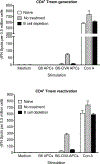Contrasting effects of B cell depletion on CD4+ and CD8+ memory T cell responses generated after transplantation
- PMID: 32185859
- PMCID: PMC7483880
- DOI: 10.1111/ajt.15858
Contrasting effects of B cell depletion on CD4+ and CD8+ memory T cell responses generated after transplantation
Abstract
Alloreactive memory T cells play a key role in transplantation by accelerating allograft rejection and preventing tolerance induction. Some studies using µMT mice, which are constitutionally devoid of B cells, showed that B cells were required for the generation of memory T cells after allotransplantation. However, whether B cell depletion in normal adult mice has the same effect on memory responses by CD4+ and CD8+ T cells activated after transplantation has not been thoroughly investigated. In this study, we tested the effect of anti-CD20 antibody-mediated B cell depletion on CD4+ and CD8+ memory T cell alloresponses after skin transplantation in wild-type mice. We found that B cell depletion prevented the development of memory alloresponses by CD4+ T cells but enhanced that of CD8+ memory T cells. Next, we tested the influence of B cell depletion on hematopoietic chimerism. In OT-II CD4+ anti-OVA TCR transgenic mice sensitized to ovalbumin antigen, B cell depletion also impaired allospecific memory T cell responses and thereby enhanced donor hematopoietic chimerism and T cell deletion after bone marrow transplantation. This study underscores the complexity of the relationships between B and T cells in the generation and reactivation of different memory T cell subsets after transplantation.
Keywords: T cell biology; basic (laboratory) research/science; immunobiology; rejection: T cell mediated (TCMR).
© 2020 The American Society of Transplantation and the American Society of Transplant Surgeons.
Figures



Similar articles
-
B Cell Depletion With an Anti-CD20 Antibody Enhances Alloreactive Memory T Cell Responses After Transplantation.Am J Transplant. 2016 Feb;16(2):672-8. doi: 10.1111/ajt.13483. Epub 2015 Nov 9. Am J Transplant. 2016. PMID: 26552037 Free PMC article.
-
B cell activating factor (BAFF) and a proliferation inducing ligand (APRIL) mediate CD40-independent help by memory CD4 T cells.Am J Transplant. 2015 Feb;15(2):346-57. doi: 10.1111/ajt.12984. Epub 2014 Dec 12. Am J Transplant. 2015. PMID: 25496308 Free PMC article.
-
Regulation of skin and islet allograft survival in mice treated with costimulation blockade is mediated by different CD4+ cell subsets and different mechanisms.Transplantation. 2004 Sep 15;78(5):660-7. doi: 10.1097/01.tp.0000130449.05412.96. Transplantation. 2004. PMID: 15371665
-
Skin allograft maintenance in a new synchimeric model system of tolerance.J Immunol. 2001 Dec 1;167(11):6623-30. doi: 10.4049/jimmunol.167.11.6623. J Immunol. 2001. PMID: 11714833 Free PMC article.
-
CD4+ T Cell Help Is Mandatory for Naive and Memory Donor-Specific Antibody Responses: Impact of Therapeutic Immunosuppression.Front Immunol. 2018 Feb 19;9:275. doi: 10.3389/fimmu.2018.00275. eCollection 2018. Front Immunol. 2018. PMID: 29515582 Free PMC article.
Cited by
-
Properties of regulatory B cells regulating B cell targets.Am J Transplant. 2021 Dec;21(12):3847-3857. doi: 10.1111/ajt.16772. Epub 2021 Sep 6. Am J Transplant. 2021. PMID: 34327838 Free PMC article.
-
The Entangled World of Memory T Cells and Implications in Transplantation.Transplantation. 2024 Jan 1;108(1):137-147. doi: 10.1097/TP.0000000000004647. Epub 2023 Dec 13. Transplantation. 2024. PMID: 37271872 Free PMC article. Review.
-
Vaccine Considerations for Multiple Sclerosis in the COVID-19 Era.Adv Ther. 2021 Jul;38(7):3550-3588. doi: 10.1007/s12325-021-01761-3. Epub 2021 Jun 1. Adv Ther. 2021. PMID: 34075554 Free PMC article. Review.
-
B cell depletion with anti-CD20 mAb exacerbates anti-donor CD4+ T cell responses in highly sensitized transplant recipients.Sci Rep. 2021 Sep 13;11(1):18180. doi: 10.1038/s41598-021-97748-9. Sci Rep. 2021. PMID: 34518640 Free PMC article.
References
-
- Heeger PS, Greenspan NS, Kuhlenschmidt S, Dejelo C, Hricik DE, Schulak JA et al. Pretransplant frequency of donor-specific, IFN-gamma-producing lymphocytes is a manifestation of immunologic memory and correlates with the risk of posttransplant rejection episodes. Journal of Immunology 1999;163(4):2267–2275. - PubMed
-
- Pantenburg B, Heinzel F, Das L, Heeger PS, Valujskikh A. T cells primed by Leishmania major infection cross-react with alloantigens and alter the course of allograft rejection. J Immunol 2002;169(7):3686–3693. - PubMed
Publication types
MeSH terms
Grants and funding
LinkOut - more resources
Full Text Sources
Research Materials

